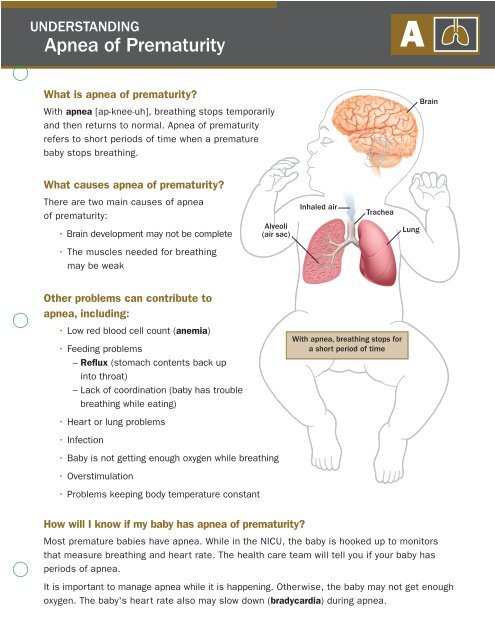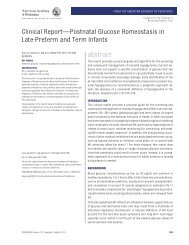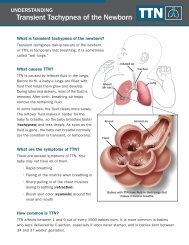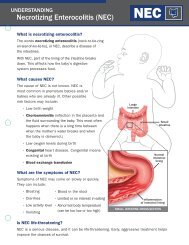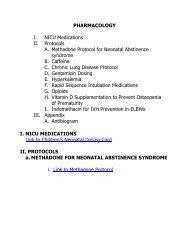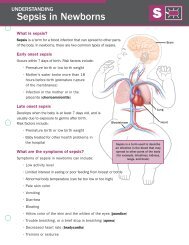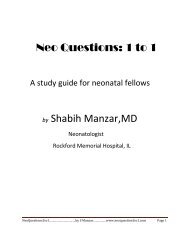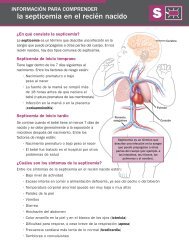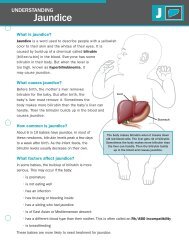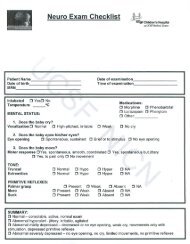Apnea of Prematurity - Associates in Newborn Medicine
Apnea of Prematurity - Associates in Newborn Medicine
Apnea of Prematurity - Associates in Newborn Medicine
Create successful ePaper yourself
Turn your PDF publications into a flip-book with our unique Google optimized e-Paper software.
UNDERSTANDING<strong>Apnea</strong> <strong>of</strong> <strong>Prematurity</strong>AWhat is apnea <strong>of</strong> prematurity?With apnea [ap-knee-uh], breath<strong>in</strong>g stops temporarilyand then returns to normal. <strong>Apnea</strong> <strong>of</strong> prematurityrefers to short periods <strong>of</strong> time when a prematurebaby stops breath<strong>in</strong>g.Bra<strong>in</strong>What causes apnea <strong>of</strong> prematurity?There are two ma<strong>in</strong> causes <strong>of</strong> apnea<strong>of</strong> prematurity:• Bra<strong>in</strong> development may not be completeAlveoli(air sac)Inhaled airTracheaLung• The muscles needed for breath<strong>in</strong>gmay be weakOther problems can contribute toapnea, <strong>in</strong>clud<strong>in</strong>g:• Low red blood cell count (anemia)• Feed<strong>in</strong>g problems– Reflux (stomach contents back up<strong>in</strong>to throat)– Lack <strong>of</strong> coord<strong>in</strong>ation (baby has troublebreath<strong>in</strong>g while eat<strong>in</strong>g)• Heart or lung problems• Infection• Baby is not gett<strong>in</strong>g enough oxygen while breath<strong>in</strong>g• Overstimulation• Problems keep<strong>in</strong>g body temperature constantWith apnea, breath<strong>in</strong>g stops fora short period <strong>of</strong> timeHow will I know if my baby has apnea <strong>of</strong> prematurity?Most premature babies have apnea. While <strong>in</strong> the NICU, the baby is hooked up to monitorsthat measure breath<strong>in</strong>g and heart rate. The health care team will tell you if your baby hasperiods <strong>of</strong> apnea.It is important to manage apnea while it is happen<strong>in</strong>g. Otherwise, the baby may not get enoughoxygen. The baby's heart rate also may slow down (bradycardia) dur<strong>in</strong>g apnea.
Treat<strong>in</strong>g <strong>Apnea</strong> <strong>of</strong> <strong>Prematurity</strong>What treatment will my baby receive?Treatment depends on how <strong>of</strong>ten the baby stops breath<strong>in</strong>gand for how long.• In general, healthy babies with a few periods <strong>of</strong> apneaper day <strong>of</strong>ten do not need treatment.– Gently touch<strong>in</strong>g the baby dur<strong>in</strong>g periods <strong>of</strong> apnea canhelp get breath<strong>in</strong>g back to normal.– Chang<strong>in</strong>g the baby’s position or feed<strong>in</strong>g the baby moreslowly also may help.• Babies who have more frequent apnea may needtreatment to help them breathe.– Medic<strong>in</strong>es like caffe<strong>in</strong>e may be used.– Extra oxygen or air may be delivered us<strong>in</strong>g a smalltube <strong>in</strong> the nose.– In a few cases, the health care team may help thebaby’s breath<strong>in</strong>g by us<strong>in</strong>g a mask and a bag or abreath<strong>in</strong>g mach<strong>in</strong>e. This mach<strong>in</strong>e might be a CPAPor a ventilator.What will happen next?Many babies respond well to treatment for apnea <strong>of</strong>prematurity; however, each baby is different. Talk to yourbaby's health care team. They can answer any questionsyou have about your baby.GlossaryAlveoli – t<strong>in</strong>y sacs <strong>in</strong> the lungsthat move oxygen from the air<strong>in</strong>to the bloodAnemia – low red blood cell count<strong>Apnea</strong> – breath<strong>in</strong>g stops for ashort period <strong>of</strong> timeBradycardia – decreasedheart rateCPAP (cont<strong>in</strong>uous positiveairway pressure) – a treatmentthat uses mild pressurized airto keep the lungs openReflux – stomach contents backup <strong>in</strong>to throatSaturation – the amount <strong>of</strong>oxygen <strong>in</strong> the blood. This isexpressed as a percentage <strong>of</strong>the total amount <strong>of</strong> oxygen thatthe blood can holdTrachea – w<strong>in</strong>dpipeVentilator – a mach<strong>in</strong>e that helpsthe baby breathe by mov<strong>in</strong>g air <strong>in</strong>and out <strong>of</strong> the lungsAsk the health care team whenyou have questions—they arethere to help.NOTES:______________________________________________________________________________________________________________________________________________________________________________________________________________________________________________________________________________________________________________________________________________________________________________________________________________________________________________________________________________________________________________________________________________________________________________________________________________________________________________________Signature: __________________________________________ Date:__________________ Time: ____________ © 2011 Ikaria, Inc. IMK111-01433 September 2011


